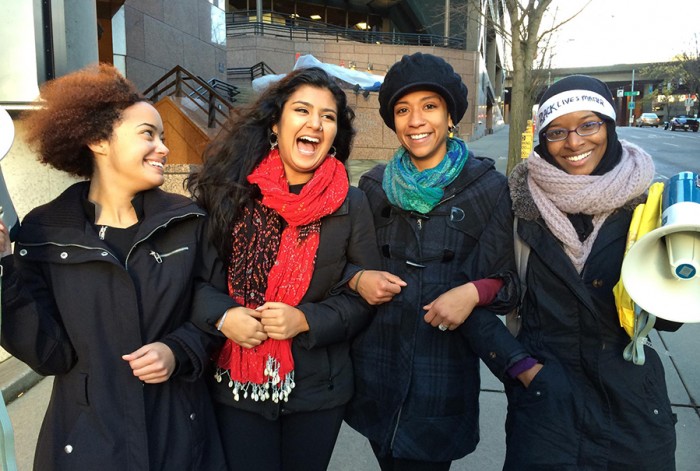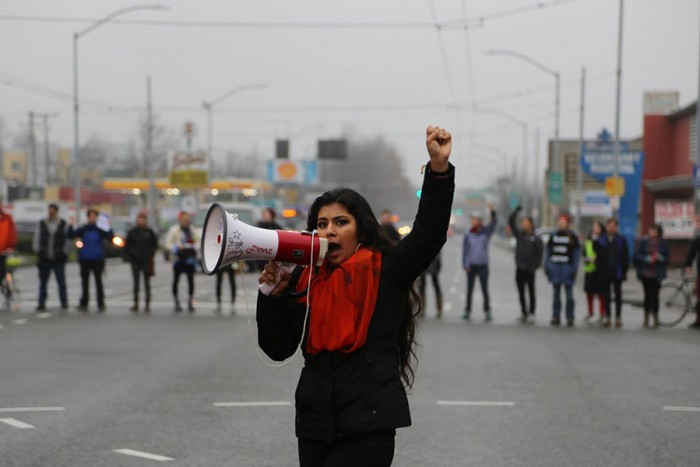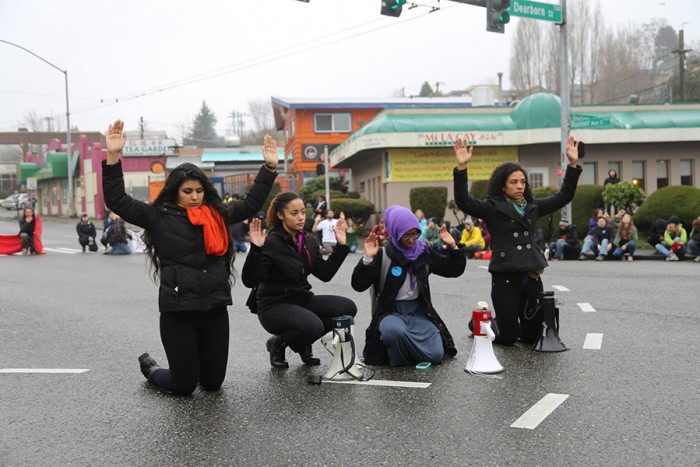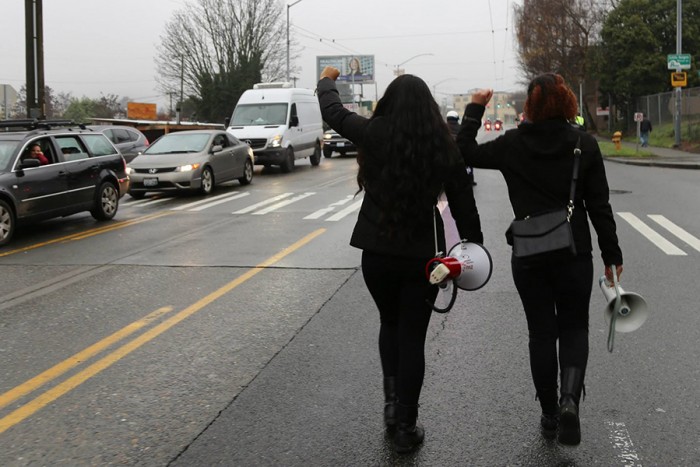
For every Mike Brown, Trayvon Martin, and Rodney King injustice, a new wave of activists seems to come out of the woodwork.
In step with Seattle’s legacy of multiracial activism are four rising young women who fit the description: Harmony Wright, Aretha Basu, Jazmine Canez and Zemzem Ahmed. Just in the last two months, they’ve formed Women of Color for Systemic Change. The group has brought out hundreds of young people to protests they’ve organized in response to a grand jury’s decision not to indict police officer Darren Wilson in the Mike Brown shooting, and subsequent Black Lives Matter demonstrations throughout Seattle.
They’re bright, hopeful, educated. Their mission? Peaceful protest, unifying action and productive dialogue with law enforcement, elected officials and community members towards police accountability.
“As women of color, our struggles have brought us together in life or being that we are of color, and our experiences and our stories have unified us and have made us so much stronger,” says 25-year-old Jazmine Canez, one of the group’s co-founders and a former immigrant rights organizer in Arizona.
Canez first met Basu, Wright and Ahmed after the Blackout Friday protest on Nov. 28, which shut down dozens of establishments in downtown Seattle after Darren Wilson’s untimely verdict.

Basu, 20, and a sophomore at University of Washington Bothell, had already been talking to her friends Harmony Wright and Zemzem Ahmed about the Black Lives Matter movement and the desire to do more justice work. The personal relevance was unavoidable.
“Let’s just look at the last couple of months,” Basu says. “The people who have been killed have all been in our age range. So it could have been one of our friends. It could have been one of our family members.”
Later, during the Nov. 28 protest, Canez overheard Basu mention she was one of the organizers for the next major protest starting at Garfield High School the following week. Canez offered to help.
“That was on a Friday, she texted me that night and the next Sunday morning, I met with the girls,” Canez says.
Since then, they have all been inseparable.
“We talk every single day — even when we’re not organizing,” says Canez, laughing. “We’ve definitely built sisterhood out of this.”
And unlike a lot of people in their late teens to mid-20s, Women of Color for Systemic Change knows exactly what they want: a more unbiased criminal justice system that evaluates police officer offenses by third-party prosecutors, a culturally competent police force and trainings for the Seattle Police Department on how to de-escalate situations without using weapons as a first response.
“Ultimately … we want constructive dialogue [with the chief of police, the mayor and other authorities] so they can implement what we want,” says Basu.
Canez mentioned the group will be spending plenty of time cornering public officials for meetings as a next step.
Basu, Wright and Ahmed emphasized the significance of people of color and young people being in front and central to the movement.

“It’s very important for people to understand that the people of color community and the African-American community — they can fight for themselves,” says Wright, a 19-year-old Garfield High School alumnus who attends UW Bothell with Basu. “They don’t need someone to fight for them. They need people to fight with them.”
The difference between “with” and “for,” according to Wright, is asking what is needed rather than imposing a need, and quite simply, “just being a little bit more open and a little more willing to listen.”
“I’m an Indian woman, and the oppressions against my community are very different from what my sisters and brothers are experiencing,” says Basu.“So first I have to understand that, and that my role is an ally, and coming with that, I am supporting them, not speaking for them. And so, also … having other people of color communities understand that this is our fight, this is all of our fights.
“Just because we have some tension within a certain community doesn’t mean that the liberation of our community isn’t tied to the liberation of a different community. All of our liberations are tied together,” Basu says.
It all goes back to unifying voices, she says.
“We look back, and we see Larry Gossett and the four amigos. They’re all different races, but they came together because they understood … that it needed to be fought from all four sides.”
In five years, Ahmed, who is 20 and in her second year at UW, hopes to see “a closer connection between elected officials and youth of color.”
“When we look at the youth detention center, most of them are youth of color. Why is that? Those questions need to be answered.”
The young women have gotten an inordinate amount of attention, mostly in the form of support. From the first Dec. 6 protest they organized together alone, Canez says, hundreds of comments and photos were being posted within minutes of the protests ending. Many of those posting were “calling us leaders and thanking us for our work,” she says.
“It was amazing. Since then, it has grown from people verbally to physically wanting to help us.”
In addition to many organizations and youth programs requesting them to do workshops, Seattle city council member Kshama Sawant has reached out to work with them. King County council member Larry Gossett, and one of Seattle’s Gang of Four, has also offered them his mentorship.
So far — knock on wood — anything negative has been eclipsed by the overwhelming amount of support they’ve received.
“Because they see that we’re trying to bring youth along, and they see that there’s a lot of power in youth,” says Ahmed.


